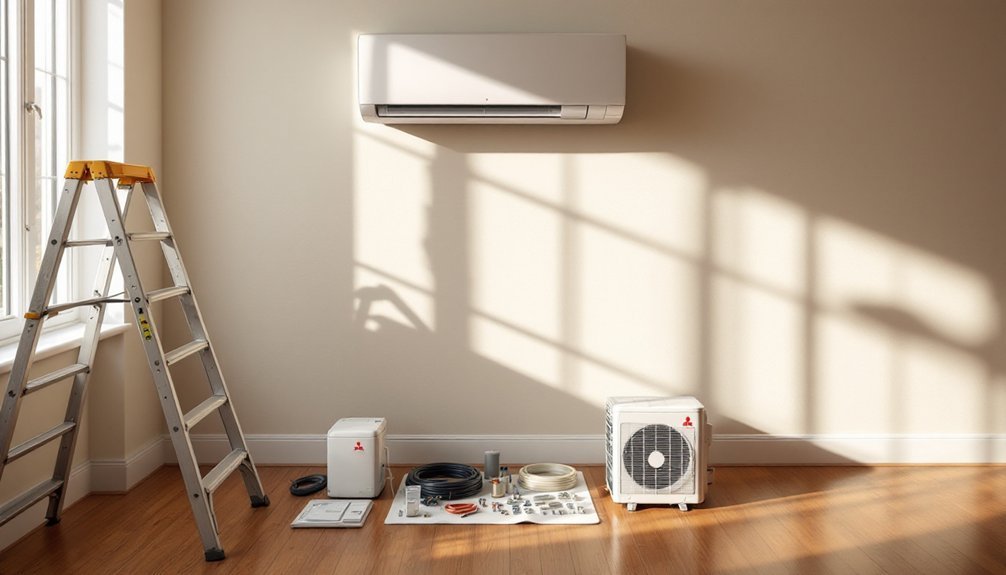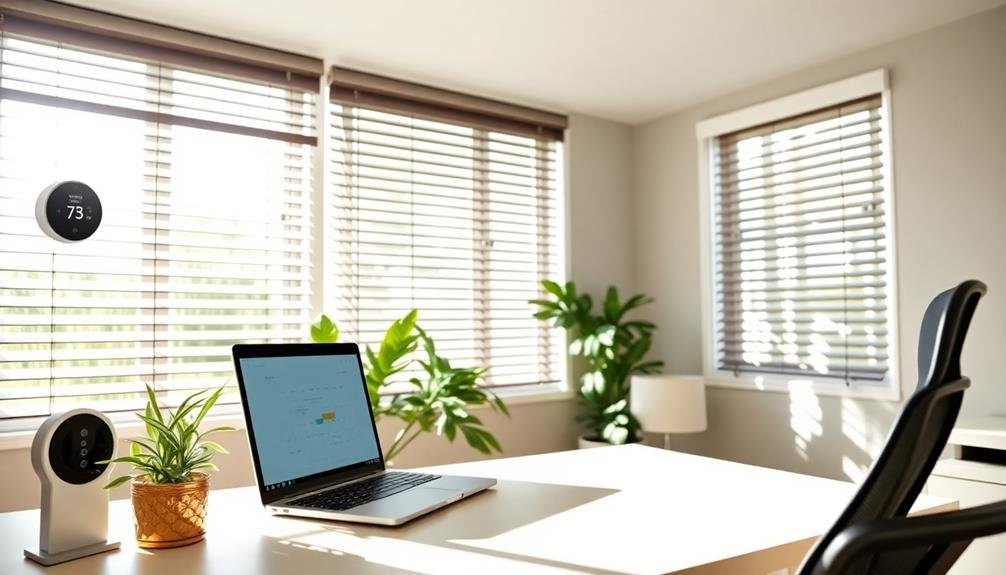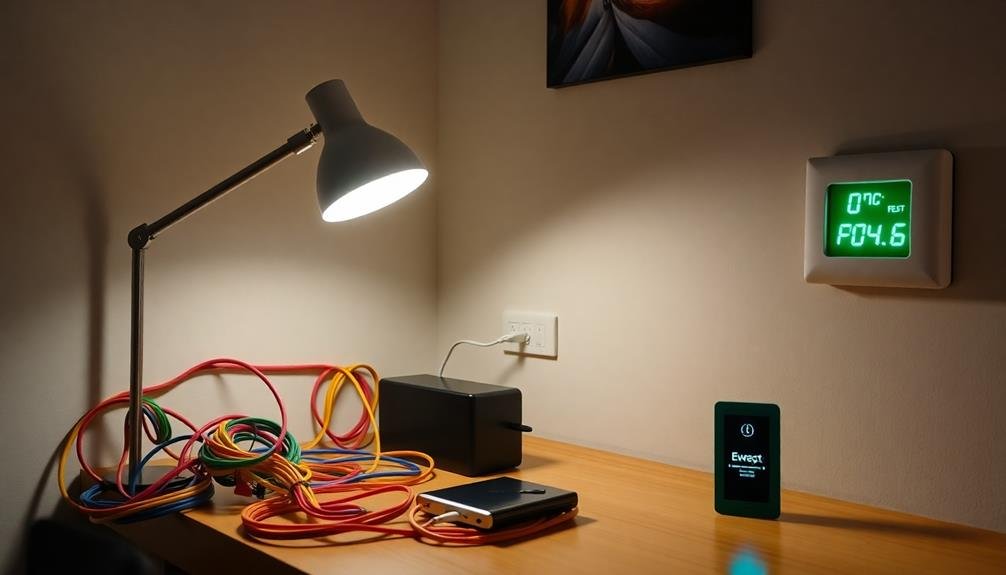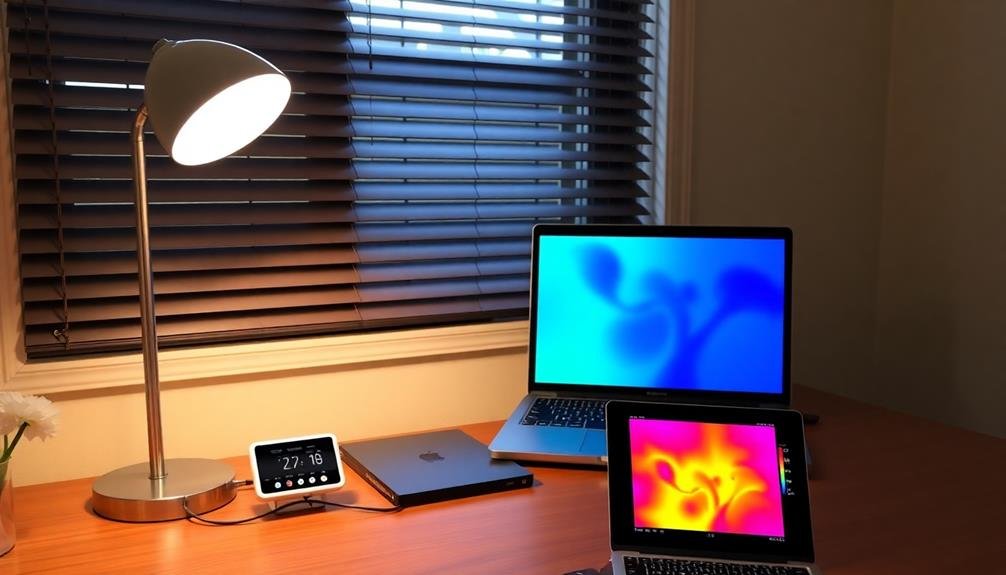You're about to discover why DIY mini split heat pump installation isn't as intimidating as you might think. With the right system, you can transform your home's comfort while saving thousands on professional installation costs. The latest 2025 models offer user-friendly features and thorough installation kits that make the process surprisingly manageable. Before you pick up those tools, though, there's essential information you'll need to guarantee you select the perfect unit for your space.
Daikin 9,000 BTU Mini Split Heat Pump System (RXC09)
The Daikin 9,000 BTU Mini Split System excels in spaces where traditional HVAC systems prove impractical, making it a prime choice for homeowners tackling retrofit projects or room additions.
You'll appreciate its versatility in cooling and heating spaces up to 400 square feet, with operation ranges from 50°F to 115°F for cooling and 5°F to 65°F for heating. The system delivers impressive efficiency ratings with 18 SEER2 and 9 HSPF2, while featuring advanced technologies like ECO+ mode and Blue Fin Protection. The package includes everything you'll need: indoor unit, outdoor condenser, remote control, mounting bracket, and a 15-foot installation kit with pre-charged refrigerant lines.
Best For: Homeowners looking to add efficient heating and cooling to spaces up to 400 sq. ft. where traditional ductwork isn't feasible, such as garage conversions, sunrooms, or home additions.
Pros:
- High energy efficiency with 18 SEER2 rating and ECO+ mode for cost-effective operation
- Complete installation kit included with pre-charged refrigerant lines and mounting hardware
- Versatile operation range for both heating (5°F-65°F) and cooling (50°F-115°F)
Cons:
- Professional installation recommended, adding to overall cost
- Limited to heating and cooling spaces up to 400 sq. ft.
- May not be suitable for extremely cold climates as heating efficiency decreases in sub-zero temperatures
ACiQ Essentials 12000 BTU Mini Split AC/Heating System
Perfect for spaces between 400-600 square feet, ACiQ's Essentials 12000 BTU Mini Split system delivers efficient heating and cooling with an impressive 19 SEER2 rating.
While it comes with a complete installation kit including a 16ft line set and mounting accessories, you'll need professional installation as this isn't a DIY-friendly unit. You'll appreciate its smart features like self-cleaning, eco mode, and WiFi control through your smartphone. The system operates quietly at 27-42 dBA indoors and handles extreme temperatures from -4°F to 122°F. It's backed by a solid 4-year parts and 6-year compressor warranty when registered online.
Best For: Homeowners or renters with medium-sized rooms (400-600 sq ft) seeking an efficient, smart-enabled heating and cooling solution with professional installation.
Pros:
- High efficiency ratings (19 SEER2) and wide operating temperature range (-4°F to 122°F)
- Comprehensive installation kit included with all necessary components
- Quiet operation (27-42 dBA indoor) with smart features like WiFi control and self-cleaning
Cons:
- Professional installation required, adding to overall cost
- Higher amp requirement (17-25 amps) may need electrical upgrades
- Limited customer reviews available due to being a newer product
DELLA Versa Series 12000 BTU Mini Split Air Conditioner with Alexa
Advanced DIYers seeking a powerful yet efficient climate solution will find the DELLA Versa Series 12000 BTU Mini Split appealing, though it's not a true DIY installation system. You'll need professional-grade tools, including a vacuum pump and manifold gauges, plus expertise in electrical work.
This ETL-listed unit offers impressive specs: 19 SEER2 rating, heating capability down to -4°F, and coverage for up to 550 sq ft. You'll appreciate the ultra-quiet 42 dBa operation and smart features like Alexa integration, 4D airflow, and multiple operating modes. While customer support is excellent, remember you'll face significant installation work, including wall modifications and refrigerant line adjustments.
Best For: Advanced DIY homeowners and tech-savvy users seeking a high-efficiency heating and cooling solution for spaces up to 550 sq ft, who are comfortable with complex installation requirements.
Pros:
- Impressive energy efficiency with 19 SEER2 rating and DC inverter technology that saves up to 30% on power
- Comprehensive smart features including Alexa integration, 4D airflow, and multiple operating modes
- Ultra-quiet operation at 42 dBa and excellent performance in both heating (down to -4°F) and cooling modes
Cons:
- Requires professional-grade tools and expertise for installation, including vacuum pump and manifold gauges
- Significant additional costs for installation materials and potential electrical modifications
- Complex installation process requires knowledge of refrigerant handling and electrical systems
YITAHOME 12000 BTU Mini Split Air Conditioner Heat Pump System
Homeowners seeking efficient climate control for spaces up to 750 square feet will find an ideal match in YITAHOME's 12000 BTU mini-split system. This WiFi-enabled unit boasts an impressive 20 SEER2 rating and operates effectively in temperatures from 5°F to 118°F.
You'll appreciate its whisper-quiet operation at under 41 decibels and five versatile modes including cooling, heating, and dehumidification. The system's smart features include Alexa compatibility, iFEEL mode, and automatic self-cleaning. While professional installation is required, you'll benefit from 25% energy savings compared to traditional systems. Just be aware that some users report issues with line set quality and missing components.
Best For: Homeowners and small business owners looking for an energy-efficient, smart-enabled cooling and heating solution for spaces up to 750 square feet, such as bedrooms, living rooms, or small offices.
Pros:
- Highly energy efficient with 20 SEER2 rating and 25% energy savings compared to traditional systems
- Quiet operation under 41 decibels with multiple smart features including WiFi connectivity and Alexa compatibility
- Versatile performance with five operational modes and wide temperature range (5°F to 118°F)
Cons:
- Professional installation required, adding to overall cost
- Some users report issues with missing components or inadequate line sets
- Ships in two packages, which can lead to delivery coordination challenges
KLIMAIRE 12,000 BTU Mini Split Heat Pump Air Conditioner
DIY enthusiasts seeking an efficient climate control solution will appreciate the KLIMAIRE 12,000 BTU Mini Split Heat Pump's complete installation package. The unit comes with pre-charged 25-ft quick-connect lines and a plug-and-play cable, making installation straightforward without voiding the warranty.
You'll get impressive performance from this 19 SEER2 system, which cools spaces up to 550 sq. ft. and operates in temperatures from -13°F to 5°F. The unit features smart connectivity through the Smart Life App, working with Alexa and Google Home. While some users report missing screws and translation issues, the system's self-cleaning technology, multi-stage filtration, and robust 5-year parts warranty make it a solid choice.
Best For: DIY homeowners looking for a smart, energy-efficient mini-split system that can be self-installed to cool and heat medium-sized rooms up to 550 square feet.
Pros:
- Complete DIY installation kit with pre-charged lines and no special tools required
- High efficiency rating (19 SEER2) with wide operating temperature range (-13°F to 5°F)
- Smart home integration with multiple comfort features and advanced air filtration system
Cons:
- Some users report missing hardware and installation components
- Instructions could be more detailed for DIY installation
- Quality control issues with bent fins and remote control translation problems
DELLA Motto 12000 BTU WiFi Mini Split Air Conditioner & Heat Pump
The DELLA Motto 12000 BTU mini split system stands out as a versatile climate solution for spaces up to 550 square feet, making it perfect for garages, home offices, or master bedrooms.
You'll appreciate its impressive 20 SEER2 efficiency rating and smart features like WiFi connectivity and Alexa compatibility. The system operates quietly at 41 dBa and functions in temperatures as low as 19°F. Its inverter technology delivers up to 30% power savings, while the R32 refrigerant reduces environmental impact.
While professional installation is recommended, DIY enthusiasts can tackle the project with proper tools like a torque wrench and HVAC vacuum pump. The included 13ft copper line and 6.56ft drain pipe simplify installation.
Best For: Homeowners and property managers seeking an efficient, smart-enabled heating and cooling solution for medium-sized spaces up to 550 square feet, such as master bedrooms, home offices, or garages.
Pros:
- High energy efficiency with 20 SEER2 rating and up to 30% power savings through inverter technology
- Smart features including WiFi connectivity, Alexa compatibility, and multiple operating modes
- Quiet operation at 41 dBa and effective performance in temperatures as low as 19°F
Cons:
- Professional installation recommended, which adds to overall cost
- Some users report unclear wiring instructions and installation documentation
- Temperature discrepancies reported by some users, with unit running slightly warmer than set point
Mini Split Air Conditioner & Heater with Installation Kit
Modern climate control meets user-friendly design in this 12,000 BTU mini split system that's perfect for hands-on installers seeking efficient heating and cooling. You'll appreciate its impressive 17 SEER2 rating and whisper-quiet 22dB sleep mode operation.
The all-encompassing installation kit includes everything you need: indoor and outdoor units, copper pipes, power lines, and a remote control. While some users report manual discrepancies and remote control limitations, the unit's performance stands out, effectively heating even in 1°F conditions. Customer support remains responsive, quickly addressing concerns and replacing faulty parts when needed.
Best For: DIY homeowners with basic HVAC knowledge seeking an energy-efficient, complete mini-split system solution for single-room climate control.
Pros:
- Excellent energy efficiency with 17 SEER2 rating and energy-conserving modes
- Ultra-quiet operation at 22dB in sleep mode
- Comprehensive installation kit includes all necessary components
Cons:
- Manual contains some conflicting information and unclear instructions
- Initial remote control only displays Celsius temperatures
- Build quality may not match premium brand expectations
Factors to Consider When Choosing the Most Efficient Mini Split Heat Pumps for DIY Installation
When selecting a mini split heat pump for your DIY project, you'll need to evaluate vital factors like SEER and HSPF energy ratings, available installation space both indoors and outdoors, and your region's climate requirements. You'll also want to verify your home's electrical capacity matches the unit's power demands and guarantee proper voltage compatibility. The installation kit should include all essential components like mounting brackets, line sets, and electrical connections to complete your DIY installation successfully.
Energy Efficiency Ratings Explained
Understanding efficiency ratings is essential for selecting the right mini split heat pump for your DIY installation. You'll need to focus on two primary ratings: SEER for cooling and HSPF for heating efficiency.
When evaluating cooling performance, look for a SEER rating of 18 or higher – this means your system will deliver 18 BTUs of cooling for each watt of electricity used. For heating efficiency, target an HSPF rating above 8, which indicates superior performance during cold weather. You can also check the EER and COP ratings, where higher numbers reflect better energy utilization in both cooling and heating modes.
Installation Space Requirements
Proper space planning lies at the heart of a successful mini split heat pump installation. You'll need to measure your room's dimensions carefully, as indoor units cover between 400 to 750 square feet, depending on their BTU rating. Confirm you've got sufficient wall space to mount the indoor unit, which typically requires an area of about 11 x 31 x 8 inches.
For the outdoor component, you'll want a location with adequate airflow and easy maintenance access. Most outdoor units need roughly 21 to 26 inches in both width and height. Don't forget to plan your refrigerant line route, which requires space for 1/4 and 3/8 inch copper pipes, plus drainage for condensate. Consider your climate too – check that your chosen unit can handle your area's temperature extremes, typically from -4°F to 115°F.
Climate Zone Compatibility
The right mini split heat pump for your home depends heavily on your local climate zone. You'll need to match your unit's operating temperature range to your region's weather patterns to guarantee peak performance year-round. For cold climates, look for models that can operate effectively in temperatures as low as -13°F, while warmer regions may only need units that function down to -4°F.
Check the SEER2 and HSPF2 ratings to gauge efficiency across different weather conditions. Higher ratings mean better performance and potentially lower energy bills. If you live in a humid area, pay attention to the unit's dehumidification capacity – some models can remove up to 1.6 liters of moisture per hour. Remember to take into account your space requirements, as most units are designed to condition areas between 400 and 750 square feet.
Power Source Considerations
Power source compatibility stands as a critical factor when selecting a mini split heat pump for DIY installation. You'll need to verify whether your home's electrical system can handle either 110/120V or 208/230V units, as choosing the wrong voltage could prevent proper operation or require costly electrical upgrades.
Check your home's electrical capacity against the unit's amperage requirements, which typically range from 15 to 25 amps. Don't forget to review the energy efficiency ratings – higher SEER and HSPF numbers will translate to lower utility bills over time. Additionally, you'll want to take into account the type of refrigerant used in the system. Modern units featuring R32 refrigerant offer superior efficiency and environmental benefits compared to older R410A systems. Remember to factor in any specialized tools or materials needed for installation.
Equipment Kit Components
Beyond electrical requirements, a complete mini split heat pump kit needs specific components for successful DIY installation. You'll want to verify your kit includes pre-charged refrigerant lines, mounting brackets, communication wires, and a remote control. The line set length should match your installation needs, typically ranging from 16 to 25 feet.
Don't overlook the importance of a drain hose for condensate management, as proper water removal is essential for peak performance. Look for kits that include thorough installation instructions and specify required tools like torque wrenches or vacuum pumps. If you're new to HVAC installations, consider selecting a plug-and-play system that's designed for DIY-friendly setup. These systems minimize the need for specialized knowledge while verifying proper installation.
Cost Vs Performance Analysis
Smart homeowners know that balancing cost and performance is essential when selecting a mini split heat pump for DIY installation. While higher SEER2 ratings of 19 or above offer superior energy efficiency, you'll need to weigh these long-term savings against upfront costs.
Consider that DIY-friendly systems often include extensive installation kits, which can offset the initial investment in more efficient models. You'll save up to 30% on energy bills with high-performance units, making them worth the extra cost in many cases. However, don't focus solely on price – evaluate the system's BTU capacity and operational temperature range for your specific needs. A cheaper unit might require additional systems to cover your space effectively, potentially costing more in the long run than a single higher-capacity model.
Frequently Asked Questions
How Long Does a Diy-Installed Mini Split Heat Pump Typically Last?
You can expect your DIY-installed mini split heat pump to last 15-20 years with proper maintenance. However, you'll get better longevity if you perform regular cleaning, filter changes, and annual professional check-ups.
Can I Install a Mini Split System in a Rental Property?
You'll need your landlord's written permission before installing a mini split in a rental. While it's technically possible, many lease agreements prohibit major modifications. Always check your rental contract and local regulations first.
What Tools Are Required for DIY Mini Split Installation?
You'll need a drill, level, vacuum pump, manifold gauge set, flaring tool, torque wrench, hole saw, wire strippers, mounting brackets, and basic hand tools like screwdrivers and wrenches for DIY mini split installation.
Do Mini Splits Work Effectively in Extremely Cold Climates?
You'll find that modern mini splits work well in cold climates. Many units operate efficiently down to -13°F, and some premium models even perform at -22°F. You'll just need to choose a cold-climate rated model.
How Often Should I Perform Maintenance on My Diy-Installed Mini Split System?
You'll need to clean air filters monthly, inspect the outdoor unit quarterly, and schedule professional maintenance annually. Regularly check for debris, clean the coils, and monitor refrigerant levels to guarantee peak performance.





Leave a Reply